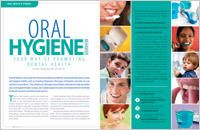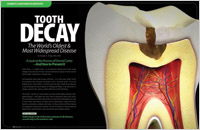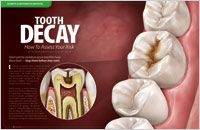
Why not? Sometimes, it’s because we don’t have the manual dexterity to handle the floss, or because braces or partial dentures get in the way; or, perhaps we just never got in the habit. Yet proper cleaning of the interdental areas (the small spaces between teeth) is crucial — and here’s why:
Consistent brushing with fluoride toothpaste has been proven effective at removing dental plaque from the tooth’s surfaces and making them more resistant to decay. But regular toothbrushes simply can’t get into the small gaps between teeth, or the tiny crevices where teeth meet gums. Unfortunately for our oral health, that’s exactly where tooth decay and gum disease starts — and that’s where the tools called “interdental cleaners” can help.
There are several different types of interdental cleaners available, including special brushes and irrigation devices (commonly called “water picks”). None of them, by themselves, are a substitute for brushing and flossing. However, as part of a regular program of oral hygiene, they can be effective at fighting plaque and reducing the incidence of tooth decay and gum disease.
The Interdental Brush

The cleaning surface of an interdental brush is similar in shape to a small, conical pipe cleaner. Its short bristles radiate from a thin central wire, which is small enough to pass through a very tight space. The brushes are available with both coated and uncoated wire, and come in different widths to accommodate an individual’s particular dental anatomy. When needed, they can also be used to apply antibacterial or desensitizing agents to certain areas of the teeth or gums.
Oral Irrigation Devices
Available to consumers for over 50 years, these devices (sometimes known as water jets or water picks) can also play a role in interdental hygiene. While their popularity has gone up and down over the decades, many studies have shown that they provide a safe and effective method of diluting the acids produced by plaque. Irrigation devices typically use pulsed or steady jets of pressurized water to remove food particles from the hard-to-clean interdental spaces, as well as in some subgingival (below the gum line) pockets.
Proper brushing and flossing is still generally considered the gold standard of at-home oral hygiene. But if you have trouble flossing regularly — or if you’re at increased risk for developing dental or periodontal disease — then using these interdental cleaners might be right for you.
Related Articles

Oral Hygiene Behavior — Dental Health for Life The best tools for maintaining your oral health and minimizing dental problems are a quality toothbrush, toothpaste, a roll of dental floss, approved mouthwash and good diet. This article details a winning game plan for oral health… Read Article

Tooth Decay — A Preventable Disease Tooth decay is the number one reason children and adults lose teeth during their lifetime. Yet many people don’t realize that it is a preventable infection. This article explores the causes of tooth decay, its prevention, and the relationship to bacteria, sugars, and acids… Read Article

Tooth Decay – How To Assess Your Risk Don’t wait for cavities to occur and then have them fixed — stop them before they start. Modern dentistry is moving towards an approach to managing tooth decay that is evidence-based — on years of accumulated, systematic, and valid scientific research. This article discusses what you need to know to assess your risk and change the conditions that lead to decay… Read Article
